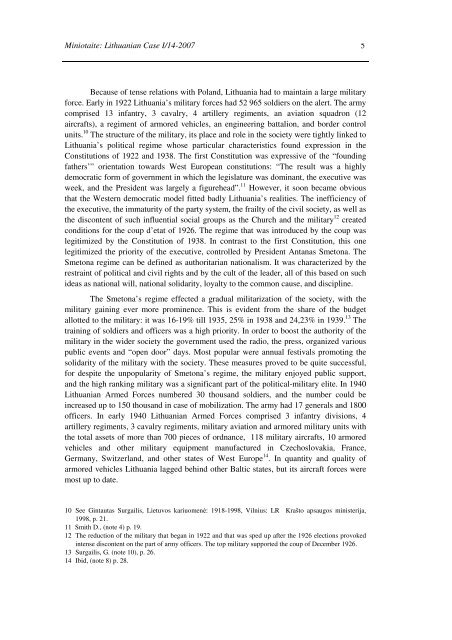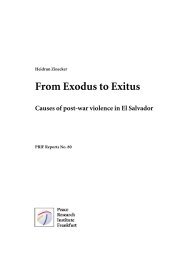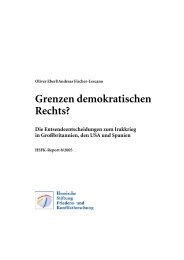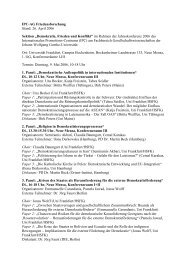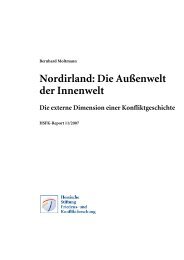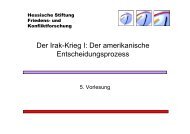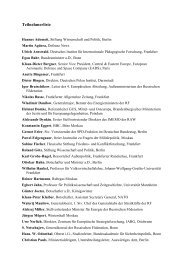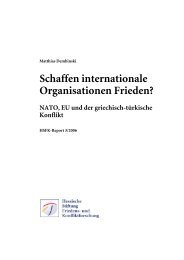The Normative Construction of the Military in Lithuania - HSFK
The Normative Construction of the Military in Lithuania - HSFK
The Normative Construction of the Military in Lithuania - HSFK
You also want an ePaper? Increase the reach of your titles
YUMPU automatically turns print PDFs into web optimized ePapers that Google loves.
M<strong>in</strong>iotaite: <strong>Lithuania</strong>n Case I/14-2007<br />
Because <strong>of</strong> tense relations with Poland, <strong>Lithuania</strong> had to ma<strong>in</strong>ta<strong>in</strong> a large military<br />
force. Early <strong>in</strong> 1922 <strong>Lithuania</strong>’s military forces had 52 965 soldiers on <strong>the</strong> alert. <strong>The</strong> army<br />
comprised 13 <strong>in</strong>fantry, 3 cavalry, 4 artillery regiments, an aviation squadron (12<br />
aircrafts), a regiment <strong>of</strong> armored vehicles, an eng<strong>in</strong>eer<strong>in</strong>g battalion, and border control<br />
units. 10 <strong>The</strong> structure <strong>of</strong> <strong>the</strong> military, its place and role <strong>in</strong> <strong>the</strong> society were tightly l<strong>in</strong>ked to<br />
<strong>Lithuania</strong>’s political regime whose particular characteristics found expression <strong>in</strong> <strong>the</strong><br />
Constitutions <strong>of</strong> 1922 and 1938. <strong>The</strong> first Constitution was expressive <strong>of</strong> <strong>the</strong> “found<strong>in</strong>g<br />
fa<strong>the</strong>rs’” orientation towards West European constitutions: “<strong>The</strong> result was a highly<br />
democratic form <strong>of</strong> government <strong>in</strong> which <strong>the</strong> legislature was dom<strong>in</strong>ant, <strong>the</strong> executive was<br />
week, and <strong>the</strong> President was largely a figurehead”. 11 However, it soon became obvious<br />
that <strong>the</strong> Western democratic model fitted badly <strong>Lithuania</strong>’s realities. <strong>The</strong> <strong>in</strong>efficiency <strong>of</strong><br />
<strong>the</strong> executive, <strong>the</strong> immaturity <strong>of</strong> <strong>the</strong> party system, <strong>the</strong> frailty <strong>of</strong> <strong>the</strong> civil society, as well as<br />
<strong>the</strong> discontent <strong>of</strong> such <strong>in</strong>fluential social groups as <strong>the</strong> Church and <strong>the</strong> military 12 created<br />
conditions for <strong>the</strong> coup d’etat <strong>of</strong> 1926. <strong>The</strong> regime that was <strong>in</strong>troduced by <strong>the</strong> coup was<br />
legitimized by <strong>the</strong> Constitution <strong>of</strong> 1938. In contrast to <strong>the</strong> first Constitution, this one<br />
legitimized <strong>the</strong> priority <strong>of</strong> <strong>the</strong> executive, controlled by President Antanas Smetona. <strong>The</strong><br />
Smetona regime can be def<strong>in</strong>ed as authoritarian nationalism. It was characterized by <strong>the</strong><br />
restra<strong>in</strong>t <strong>of</strong> political and civil rights and by <strong>the</strong> cult <strong>of</strong> <strong>the</strong> leader, all <strong>of</strong> this based on such<br />
ideas as national will, national solidarity, loyalty to <strong>the</strong> common cause, and discipl<strong>in</strong>e.<br />
<strong>The</strong> Smetona’s regime effected a gradual militarization <strong>of</strong> <strong>the</strong> society, with <strong>the</strong><br />
military ga<strong>in</strong><strong>in</strong>g ever more prom<strong>in</strong>ence. This is evident from <strong>the</strong> share <strong>of</strong> <strong>the</strong> budget<br />
allotted to <strong>the</strong> military: it was 16-19% till 1935, 25% <strong>in</strong> 1938 and 24,23% <strong>in</strong> 1939. 13 <strong>The</strong><br />
tra<strong>in</strong><strong>in</strong>g <strong>of</strong> soldiers and <strong>of</strong>ficers was a high priority. In order to boost <strong>the</strong> authority <strong>of</strong> <strong>the</strong><br />
military <strong>in</strong> <strong>the</strong> wider society <strong>the</strong> government used <strong>the</strong> radio, <strong>the</strong> press, organized various<br />
public events and “open door” days. Most popular were annual festivals promot<strong>in</strong>g <strong>the</strong><br />
solidarity <strong>of</strong> <strong>the</strong> military with <strong>the</strong> society. <strong>The</strong>se measures proved to be quite successful,<br />
for despite <strong>the</strong> unpopularity <strong>of</strong> Smetona’s regime, <strong>the</strong> military enjoyed public support,<br />
and <strong>the</strong> high rank<strong>in</strong>g military was a significant part <strong>of</strong> <strong>the</strong> political-military elite. In 1940<br />
<strong>Lithuania</strong>n Armed Forces numbered 30 thousand soldiers, and <strong>the</strong> number could be<br />
<strong>in</strong>creased up to 150 thousand <strong>in</strong> case <strong>of</strong> mobilization. <strong>The</strong> army had 17 generals and 1800<br />
<strong>of</strong>ficers. In early 1940 <strong>Lithuania</strong>n Armed Forces comprised 3 <strong>in</strong>fantry divisions, 4<br />
artillery regiments, 3 cavalry regiments, military aviation and armored military units with<br />
<strong>the</strong> total assets <strong>of</strong> more than 700 pieces <strong>of</strong> ordnance, 118 military aircrafts, 10 armored<br />
vehicles and o<strong>the</strong>r military equipment manufactured <strong>in</strong> Czechoslovakia, France,<br />
Germany, Switzerland, and o<strong>the</strong>r states <strong>of</strong> West Europe 14 . In quantity and quality <strong>of</strong><br />
armored vehicles <strong>Lithuania</strong> lagged beh<strong>in</strong>d o<strong>the</strong>r Baltic states, but its aircraft forces were<br />
most up to date.<br />
10 See G<strong>in</strong>tautas Surgailis, Lietuvos kariuomen÷: 1918-1998, Vilnius: LR Krašto apsaugos m<strong>in</strong>isterija,<br />
1998, p. 21.<br />
11 Smith D., (note 4) p. 19.<br />
12 <strong>The</strong> reduction <strong>of</strong> <strong>the</strong> military that began <strong>in</strong> 1922 and that was sped up after <strong>the</strong> 1926 elections provoked<br />
<strong>in</strong>tense discontent on <strong>the</strong> part <strong>of</strong> army <strong>of</strong>ficers. <strong>The</strong> top military supported <strong>the</strong> coup <strong>of</strong> December 1926.<br />
13 Surgailis, G. (note 10), p. 26.<br />
14 Ibid, (note 8) p. 28.<br />
5


